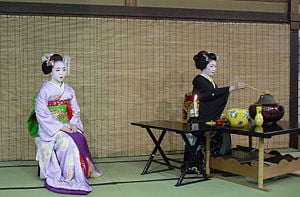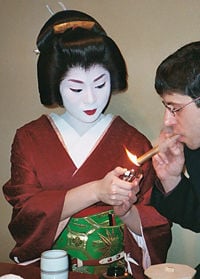Geisha
A geisha is a traditional Japanese entertainer. Often confused with a courtesan, or a prostitute, geisha instead are known for their distinct make-up and attire, their elegant and graceful dance, and their demure conversation. Evolving in the mid-eighteenth century, from the pleasure houses of Japan where courtesans would entertain the samurai, the first geisha were actually men, who entertained the guests with drums and music. However, the men were gradually replaced with female dancers, referred to as geiko, who proved much more successful and popular. The term geiko is still used to refer to senior geisha who have passed all their exams; junior geisha still in training are called maiko.
The geisha saw their peak numbers in the 1920s, with over 80,000 practicing women. But modern times, with a struggling Japanese economy and a more casual attitude towards business meetings and parties, have been hard on the geisha, and only 1000 to 2000 are left employed. Still, like many cultural traditions, the geisha has proven versatile, and many geisha houses are redesigning their traditions to be more suitable to modern demands.
Terms

"Geisha," pronounced /ˈgeɪ ʃә/, is a proper noun. Like all Japanese nouns, there are no distinct singular or plural variants of the term. The word consists of two kanji, 芸 (gei) meaning "art" and 者 (sha) meaning "person" or "doer." The most direct translation of geisha into English would be "artist" or "performing artist."
Another term used in Japan is geiko, a word from the Kyoto dialect. Full-fledged geisha in Kyoto are called geiko. This term is also commonly used in the region to distinguish geisha practiced in traditional arts from prostitutes who have co-opted the name and attire of geisha. Prostitutes wear the bow of their sash, or obi, in front of their kimono, but geisha wear their obi at the back. True geisha, who do not engage in sexual activity, usually had the luxury of a professional aide to help them in the difficult process of dressing; their clothing is made up of several layers of kimono and undergarments, and an obi is more than a simple band of cloth. Dressing could take over an hour, even with professional help. Prostitutes, however, had to take off their obi several times a day, so theirs were far less complex, and tied at the front for ease of removal and replacement.
Apprentice geisha are called maiko. This word is made of the kanji 舞 (mai), meaning "dancing" and 子 (ko), meaning "child." It is the maiko, with her white make-up and elaborate kimono and hairstyle, that has become the stereotype of a "geisha" to westerners, rather than the true geisha.
Tokyo geisha generally do not follow the ritualized maiko apprentice process, which is well established in Kyoto, where the geisha tradition is strongest. The training period can be six months to a year—notably shorter than a Kyoto maiko—before she debuts as a full geisha. The trainee is referred to as a han'gyoku (半玉) or "half-jewel," or by the more generic term o-shaku (御酌), lit. "one who pours (alcohol)." On average, Tokyo geisha tend to be older than their Kyoto counterparts, many holding formal degrees from universities.
Stages of training
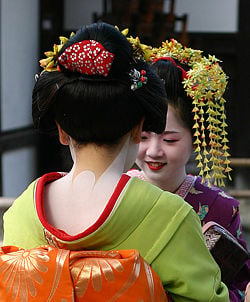
Traditionally, geishas began their training at a very young age. In earlier times some girls were sold to as children to geisha houses (okiya), located in the hanamachi (花街 "flower towns"), or geisha district, by families who felt they would have a more secure future in the okiya than in their own poor households. Later, this practice disappeared in reputable districts. Daughters of geisha were often brought up as geisha themselves, usually as the successor (atotori, meaning heir) or daughter-role (musume-bun) to the okiya.
Shikomi
The first stage of training was called shikomi. When girls first arrived at the okiya, they would be put to work as maids, who were required to do everything they are told. The work was difficult, with the intent to "make" and "break" the new girls. The most junior shikomi of the house would have to wait late into the night for the senior geisha to return from engagements, sometimes as late as two or three in the morning, and assist them in undressing and preparing to sleep. During this stage of training, the shikomi would go to classes at the hanamachi's geisha school. In modern times, this stage of training still exists, mostly to accustom the girls to the traditional dialect, traditions, and dress of the geisha lifestyle.
Minarai
Once the recruit became proficient with the geisha arts, and passed a final, difficult dance exam, she would be promoted to the second stage of training: Minarai. Minarai are relieved from their housekeeping duties. The minarai stage focuses on training in the field. Although minarai attend ozashiki (banquets in which guests are attended by geisha), they do not participate at an advanced level. Their kimono, more elaborate than even a maiko's, are intended to do the talking for them. Minarai can be hired for parties, but are usually uninvited (yet welcomed) guests at parties where their onee-san (meaning "older sister" and the Minarai's senior) is contracted to attend. They charge one-third of the hanadai, or performance fee, that the geiko receive. Minarai generally work closely with a particular tea house (called minarai-jaya) learning from the okaa-san (proprietor of the house). These techniques are not taught in school, as skills such as conversation and gaming can only be absorbed through practice. This stage lasts only about a month or so.
Maiko
After a short period of time, the third (and most famous) stage of training began, called maiko. Maiko are apprentice geisha, and this stage can last for years. Maiko learn from their senior geisha mentor and follow them around to all their engagements. The onee-san (senior) / imouto-san (junior) relationship is extremely important. Since the onee-san teaches her maiko everything about how to work in the hanamachi, her teaching is vital. She will teach her proper ways of serving tea, playing shamisen, and dancing, as well as how to succeed during casual conversation with clients. This is important for a maiko to learn in order to receive future invitations to more teahouses and gatherings. The onee-san will even help pick the maiko's new professional name with kanji, or symbols related to her own name. One would suggest that geisha are prone to "flirt," but it is only their nature to seem demure and innocent. Regional variations exist, as the han'gyoku of Tokyo are known for being sassy and the Kyoto maiko are known for being demure.
Geisha
After a period as short as six months (in Tokyo) or as long as five years (in Kyoto), the maiko is promoted to a full-fledged geisha, or geiko (in Kyoto), and charged full price for her time. Geisha remain as such until they retire.
History
While geisha themselves are not prostitutes, their roots can be found in Saburuko, late seventh century Japanese women who were forced by eroding economic conditions and social displacement to exchange sexual favors in order to survive.[1] While most Saburuko came from a low class background, there were some who were highly educated and very talented, and this upper echelon of Saburuko found themselves invited to entertain at upper class parties.
The Shirabyoshi followed in the twelfth to fourteenth centuries. During another time of economic upheaval, the daughters of rich aristocrats were forced to perform at parties in order for their families to make ends meet. Highly educated, the Shirabyoshi were valued for their poetry and for the dance for which they are named.[1] Staples of the Shirabyoshi were Shinto-style outfits, their adeptness at playing the drum and fife, and their trademark dance. Among the most famous Shirabyoshi was Shizuka, concubine of Minamoto no Yoshitsune.[1]
Recognizable geisha emerged during the eighteenth century, evolving from the courtesans of highly controlled Japanese brothels. These geisha were originally men, who began coming to the brothels to entertain the guests with music. As female geisha became more popular, they began to be called geiko, strict limits were placed on when they could work and what they could wear.[1] But geisha culture flourished under these limitations, producing great artists and performers, who separated themselves from the more elaborate dress of the courtesans, becoming fashion leaders in Japan.[2]
Exploitation
There has been a history of exploitation in the geisha business, especially during its early history. Sometimes young girls were sold by their parents into the geisha life, a practice not abolished completely until the mid-twentieth century.[2] However, this was far from common, and most geisha chose to become so of their own free will; often, geisha would train their own daughters.[2]
In addition, geisha were sometimes paid for their virginity, in a practice called mizu-age. However, these practices no longer exist for modern geisha.
Modern geisha
Modern geisha still live in traditional geisha houses called okiya in the hanamachi areas, particularly during their apprenticeship. Many experienced geisha who are successful enough choose to live independently during the later part of their careers. The elegant, high-culture world that geisha are a part of is called karyūkai (花柳界 "the flower and willow world").
Young women who wish to become geisha now most often begin their training after completing junior high school or even high school or college, with many women beginning their careers in adulthood. Geisha still study traditional instruments like the shamisen, shakuhachi (bamboo flute), and drums, as well as traditional songs, Japanese traditional dance, tea ceremony, literature, and poetry. By watching other geisha, and with the assistance of the owner of the geisha house, apprentices also become skilled in the complex traditions surrounding selecting and wearing kimono, and in dealing with clients.
Kyoto is considered by many to be the place where the geisha tradition is the strongest today. The geisha in these districts are known as geiko. The Tokyo hanamachi of Shimbashi, Asakusa, and Kagurazaka are also well known.
In modern Japan, geisha and maiko are now a rare sight outside hanamachi. In the 1920s there were over 80,000 geisha in Japan, but today there are far fewer. The exact number is unknown to outsiders, and is estimated to be from 1,000 to 2,000, mostly in the resort town of Atami.[3] More common are sightings of tourists who pay a fee to be dressed up as a maiko.
A sluggish economy, declining interest in the traditional arts, the exclusive nature of the flower and willow world, and the expense of being entertained by geisha have all contributed to the tradition's decline.
Geisha are often hired to attend parties and gatherings, traditionally at tea houses (茶屋, ochaya) or at traditional Japanese restaurants (ryōtei). Their time is measured by the time it takes an incense stick to burn, and is called senkōdai (線香代, "incense stick fee") or gyokudai (玉代 "jewel fee"). In Kyoto, the terms ohana (お花)and hanadai (花代), meaning "flower fees," are preferred. The customer makes arrangements through the geisha union office (検番 kenban), which keeps each geisha's schedule and makes her appointments both for entertaining and for training.
The world of the geisha is changing rapidly. When once one could only become a geisha through personal connections, now some training houses advertise on the internet.[3] Geisha are adapting to a new niche, and fear extinction if they are not able to find enough customers in a rapidly changing world.[3]
Geisha and prostitution
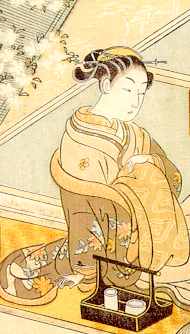
There remains some confusion, even within Japan, about the nature of the geisha profession. Geisha are frequently depicted as expensive prostitutes in Western popular culture. Geisha are entertainers, their purpose being to entertain their customer, be it by reciting verse, playing musical instruments, or engaging in light conversation. Geisha engagements may include flirting with men and playful innuendos; however, clients know that nothing more can be expected. In a social style that is uniquely Japanese, men are amused by the illusion of that which is never to be. Geisha do not engage in paid sex with clients.[4]
Geisha have sometimes been confused with the traditional high-class courtesans called oiran. Like geisha, oiran wear elaborate hairstyles and white makeup. A simple way to distinguish between the two is that oiran, as prostitutes, tie their obi in the front. Geisha tie their obi in the back in the usual manner. During the Edo period, prostitution was legal and prostitutes, such as the oiran, were licensed by the government. By contrast, geisha were strictly forbidden from holding a prostitution license and were officially forbidden to ever have sex with their customers.[5] The licensing arrangement led to the derogatory term, "double registration," referring to promiscuous geisha.
After World War II, during the American occupation of Japan, many Japanese prostitutes marketed themselves as geisha to American GIs. These prostitutes became known as geesha girls, due to a mis-pronunciation of the word geisha, and carried the image of geisha as prostitutes back to the United States.
Also, geisha working in onsen towns such as Atami were dubbed onsen geisha. Onsen geisha have been given a bad reputation due to the prevalence of prostitutes in such towns, who market themselves as "geisha," as well as sordid rumors of dance routines like "Shallow River" (which involves the 'dancers' lifting the skirts of their kimono higher and higher). In contrast to these "one-night geisha," the true onsen geisha are, in fact, competent dancers and musicians.
Personal relationships and danna
Geisha are expected to be single women; those who choose to marry must retire from the profession.
It was traditional in the past for established geisha to take a danna, or patron. A danna was typically a wealthy man, sometimes married, who had the means to support the very large expenses related to a geisha's traditional training and other costs. This sometimes occurs in modern times as well, but very rarely.
A geisha and her danna may or may not be in love, but intimacy is never viewed as a reward for the danna's financial support. The traditional conventions and values within such a relationship are very intricate and not well understood, even by many Japanese.
While it is true that a geisha is free to pursue personal relationships with men she meets through her work, such relationships are carefully chosen and unlikely to be casual. A hanamachi tends to be a very tight-knit community and a geisha's good reputation is not taken lightly.
Appearance
A geisha's appearance changes throughout her career, from the girlish, heavily made up maiko, to the more sombre appearance of an older, established geisha.
Makeup
Today, the traditional make-up of the apprentice geisha is one of their most recognizable characteristics, though established geisha generally only wear full white face makeup characteristic of maiko during special performances.
The traditional makeup of an apprentice geisha features a thick white base with red lipstick and red and black accents around the eyes and eyebrows. Originally, the white base mask was made with lead, but after the discovery that it poisoned the skin and caused terrible skin and back problems for the older geisha towards the end of the Meiji Era, it was replaced with rice powder.
The application of makeup is hard to perfect and is a time-consuming process. Makeup is applied before dressing to avoid dirtying the kimono. First, a wax or oil substance, called bintsuke-abura, is applied to the skin. Next, white powder is mixed with water into a paste and applied with a bamboo brush starting from the neck up. The white makeup covers the face, neck, and chest, with two or three unwhitened areas (forming a "W" or "V" shape, usually a traditional "W" shape) left on the nape, to accentuate this traditionally erotic area, and a line of bare skin around the hairline, which creates the illusion of a mask.
After the foundation layer is applied, a sponge is patted all over the face, throat, chest, the nape, and neck to remove excess moisture and to blend the foundation. Next, the eyes and eyebrows are drawn in. Traditionally charcoal was used, but today modern cosmetics are used. The eyebrows and edges of the eyes are colored black with a thin charcoal; a maiko also applies red around her eyes.
The lips are filled in using a small brush. The color comes in a small stick, which is melted in water. Crystallized sugar is then added to give the lips luster. Rarely will a geisha color in both lips fully in the Western style, as white creates optical illusions. The lower lip is colored in partially and the upper lip left white for maiko, while newly full-fledged geisha will color in only the top lip fully. Most geisha wear the top lip colored in fully or stylized, and the bottom lip in a curved stripe that does not follow the shape of the lip.
Maiko who are in their first stage of training will sometimes color their teeth black for a short period of time. This practice used to be common among many different classes of women in Japan, but survives only in certain districts and families.
For the first three years, a maiko wears this heavy makeup almost constantly. During her initiation, the maiko is helped with her makeup by either her onee-san, or "older sister" (an experienced geisha who is her mentor), or by the okaa-san, or "mother," of her geisha house. After this, she applies the makeup herself.
After a maiko has been working for three years, she changes her make-up to a more subdued style. The reason for this is that she has now become mature, and the simpler style shows her own natural beauty. For formal occasions, the mature geisha will still apply white make-up. For geisha over thirty, the heavy white make-up is only worn during special dances which require her to wear make up for her part.
Dress
Geisha always wear kimono. Apprentice geisha wear highly colorful kimono with extravagant obi. Always, the obi is brighter than the kimono she is wearing, to give a certain exotic balance. Maiko wear the obi tied in a style called "darari." Older geisha wear more subdued patterns and styles. The sign of a prosperous okiya is having geisha not wearing a kimono more than once, meaning that those okiyas with higher economic status will have "storehouses" of sorts where kimono are stored and interchanged between geisha.
The color, pattern, and style of kimono is also dependent on the season and the event the geisha is attending. In winter, geisha can be seen wearing a three-quarter length haori lined with hand painted silk over their kimono. Lined kimono are worn during colder seasons, and unlined kimono during the summer. A kimono can take from two to three years to complete, due to painting and embroidering.
Geiko wear red or pink nagajuban, or under-kimono. A maiko wears red with white printed patterns. The junior maiko's collar is predominantly red with white, silver, or gold embroidery. Two to three years into her apprenticeship, the red collar will be entirely embroidered in white (when viewed from the front) to show her seniority. Around age 20, her collar will turn from red to white.
Geisha wear a flat-soled sandal, zori, outdoors, and wear only tabi (white split-toed socks) indoors. In inclement weather, geisha wear raised wooden clogs, called geta. Maiko wear a special wooden clog known as okobo.
Hairstyles
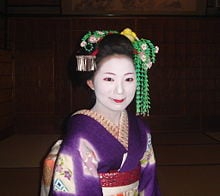
The hairstyles of geisha have varied through history. In the past, it has been common for women to wear their hair down in some periods, but up in others. During the seventeenth century, women began putting all their hair up again, and it is during this time that the traditional shimada hairstyle, a type of traditional chignon worn by most established geisha, developed.
There are four major types of the shimada: The taka shimada, a high chignon usually worn by young, single women; the tsubushi shimada, a more flattened chignon generally worn by older women; the uiwata, a chignon that is usually bound up with a piece of colored cotton crepe; and a style that resembles a divided peach, which is worn only by maiko. This is sometimes called "Momoware," or "Split Peach." Additional hairstyles: Ofuku, Katsuyama, Yakko-shimada, and sakko. Maiko of Miyagawa-cho and Pontocho will wear an additional six hairstyles leading up to the sakko. Some include: Umemodoki, Osidori no Hina, Kikugasane, and Osafune.
These hairstyles are decorated with elaborate hair combs and hairpins (kanzashi). In the seventeenth century and after the Meiji Restoration period, hair-combs were large and conspicuous, generally more ornate for higher-class women. Following the Meiji Restoration and into the modern era, smaller and less conspicuous hair combs became more popular.
Geisha were trained to sleep with their necks on small supports (takamakura), instead of pillows, so they could keep their hairstyle perfect. To reinforce this habit, their mentors would pour rice around the base of the support. If the geisha's head rolled off the support while she slept, rice would stick to her hair and face. The geisha would thus have to repeat the tiresome process of having her hair elaborately styled. Without this happening, a geisha will have her hair styled every week or so.
Many modern geisha use wigs in their professional lives, while maiko use their natural hair. However, either one must be regularly tended by highly skilled artisans. Traditional hairstyling is a slowly dying art.
Geisha in popular culture
The growing interest in geisha and their exotic appearance have spawned various popular culture phenomena both in Japan and in the West. Western interest in geisha increased with the 1998 novel and 2005 film, Memoirs of a Geisha, and the autobiography of former geisha Iwasaki Mineko, titled Geisha of Gion.
Geisha photography
- The girl inherited Maiko (apprentice geisha) life (2007) by Naoyuki Ogino at the Canon Gallery, Japan
Films featuring geisha
- Sisters of the Gion (1936)—Dir. Kenji Mizoguchi
- Geisha Girl (1952)—Dir. George P. Breakston
- A Geisha (祇園囃子, Gion bayashi) (1953)—Dir. Kenji Mizoguchi
- The Teahouse of the August Moon (1956)—Dir. Daniel Mann
- The Barbarian and the Geisha (1958)—Dir. John Huston
- The Geisha Boy (1958)—Dir. Frank Tashlin
- My Geisha (1962)—Dir. Jack Cardiff
- The World of Geisha (1972)—Dir. Tatsumi Kumashiro
- In the Realm of the Senses (1976)—Dir. Nagisa Oshima
- American Geisha (1986)—Dir. Lee Philips
- Ihara Saikaku Koshoku Ichidai Otoko (1991)—Dir. Yukio Abe
- The Geisha House (1999)—Dir. Kinji Fukasaku
- Zatoichi (2003)—Dir. Takeshi Kitano
- Fighter in the Wind (2004)—Dir. Yang Yun-ho
- Memoirs Of A Geisha (2005)—Dir. Rob Marshall
- DOA: Dead or Alive (2006)—Dir. Cory Yuen
- Maiko Haaaan!!! (2007)—Dir. Nobuo Mizuta
Music about geisha
- "Neo Geisha" by Zeromancer, on the album Eurotrash
- "Geisha Dreams" by Rollergirl
- "Latin Geisha" by Illya Kuriaki and the Valderramas
- "GEI-SHA" by S.K.I.N.
See also
- Kisaeng—Korean female entertainers, similar to Geisha
- Tea ceremony
- Kimono
Notes
- ↑ 1.0 1.1 1.2 1.3 Immortal Geisha, History of the Geisha—Part I Retrieved June 26, 2008.
- ↑ 2.0 2.1 2.2 Japanese Culture, Geisha Retrieved June 26, 2008.
- ↑ 3.0 3.1 3.2 Elaine Lies, Modern-day geisha triumphs in closed, traditional world Retrieved June 26, 2008.
- ↑ K.G. Henshall, A History of Japan (London: Macmillan Press LTD, 2001, ISBN 978-0312233709), 61.
- ↑ Women of the Arts, Misperceptions and the Story Behind It Retrieved December 3, 2007.
ReferencesISBN links support NWE through referral fees
- Dalby, Liza Crihfield. Geisha. Berkeley, CA: University of California Press, 1983. ISBN 0520047427
- Foreman, Kelly M. The Role of Music in the Lives and Identities of Japanese Geisha. Thesis (Ph. D.) Kent State University, 2002.
- Foreman, Kelly M. "Bad Girls Confined: Okuni, Geisha, and the Negotiation of Female Performance Space." In Bad Girls of Japan. Edited by Laura Miller and Jan Bardsley. New York, NY: Palgrave Macmillan Press, 2005. ISBN 1403969477
- Foreman, Kelly M. The Gei of Geisha Music, Identity and Meaning. England: Ashgate Pub. Company, 2008. ISBN 0754658570
- Gallagher, John. Geisha A Unique World of Tradition, Elegance, and Art. London: Produced by PRC Pub, 2003. ISBN 1856486974
- Golden, Arthur. Memoirs of a Geisha: A Novel. New York, NY: Alfred A. Knopf, 1997. ISBN 0375400117.
- Henshall, K.G. A History of Japan. London: Macmillan Press, 2001. ISBN 978-0312233709.
- Miyazaki, Manabu. Toppamono: Outlaw. Radical. Suspect. My Life in Japan's Underworld. Kotan Publishing, 2005. ISBN 0970171625.
Further reading
- Aihara, Kyoko. Geisha: A Living Tradition. London: Carlton Books, 2000. ISBN 1858689376
- Burns, Stanley B., and Elizabeth A. Burns. Geisha: A Photographic History, 1872–1912. Brooklyn, NY: powerHouse Books, 2006. ISBN 1576873366
- Cobb, Jodi. Geisha: The Life, the Voices, the Art. New York, NY: Alfred A. Knopf, 1995. ISBN 0679437746
- Dalby, Liza Crihfield (ed.). Ko-uta: "Little Songs" of the Geisha World (reprinted as Little Songs of the Geisha: Traditional Japanese Ko-Uta). Rutland, VT: C. E. Tuttle Co., 1979. ISBN 0804812926
- De Becker, J.E. The Nightless City: Geisha and Courtesan Life in Old Tokyo (reprint). Mineola, NY: Dover Publications, 2007. ISBN 0486455637
- Downer, Lesley. Women of the Pleasure Quarters: The Secret History of the Geisha. New York, NY: Broadway Books, 2001. ISBN 0767904893
- Ishihara, Tetsuo and Peter MacIntosh (trans.). Nihongami no Sekai: Maiko no kamigata (The World of Traditional Japanese Hairstyles: Hairstyles of the Maiko). Kyōtō: Dōhōsha Shuppan, 1993. ISBN 4810412946
- Iwasaki, Mineko, with Rande Brown. Geisha, A Life (also known as Geisha of Gion). New York, NY: Atria Books, 2002. ISBN 0743444329
- Masuda, Sayo and G.G. Rowley (trans.). Autobiography of a Geisha. New York, NY: Columbia University Press, 2003. ISBN 0231129505
- The Peabody Essex Museum (ed.). Geisha: Beyond the Painted Smile. New York, NY: George Braziller in association with the Peabody Essex Museum, 2004. ISBN 0807615455
- Perkins, Percival Densmore. Geisha of Pontocho. Photos. Tokyo: Tokyo News Service, 1954. OCLC 1904237
- Scott, A.C. The Flower and Willow World; The Story of the Geisha. New York, NY: Orion Press, 1960. ASIN B000OLMCH4
- Underwood, Eleanor. The Life of a Geisha. New York, NY: Smithmark, 1999. ISBN 0765117398
External links
All links retrieved May 24, 2017.
- Graham (Diaz), Naomi, Immortal Geisha
- Geisha Photo Gallery
- Japanese Geisha
- Geisha and Maiko on Haruyo Morita's artwoks
- Coming of Age - Yukina: Japan. BBC documentary about a modern young woman who wishes to train to be a geisha.
Credits
New World Encyclopedia writers and editors rewrote and completed the Wikipedia article in accordance with New World Encyclopedia standards. This article abides by terms of the Creative Commons CC-by-sa 3.0 License (CC-by-sa), which may be used and disseminated with proper attribution. Credit is due under the terms of this license that can reference both the New World Encyclopedia contributors and the selfless volunteer contributors of the Wikimedia Foundation. To cite this article click here for a list of acceptable citing formats.The history of earlier contributions by wikipedians is accessible to researchers here:
The history of this article since it was imported to New World Encyclopedia:
Note: Some restrictions may apply to use of individual images which are separately licensed.

